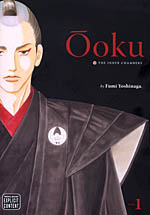 By Fumi Yoshinaga
By Fumi Yoshinaga
216 pages, black and white
Published by Viz
If you’re like me, a book called Ōoku: The Inner Chambers might make you think that perhaps an Ōoku is some huge slavering monster that lives in the depths of a cave. And like me, you would be utterly wrong. In Japan’s Edo Castle, the Ōoku was where the women who were attached to the current Shogun lived; aside from the Shogun, no other man would enter those chambers. Once I realized my error, though, I found myself drawn into Ōoku almost instantly with its alternate history concept that resulted in most of Japan’s men dying of a plague. For there, it seems, the Ōoku is something entirely different.
When a plague breaks out in 17th century Japan, over 75% of the men in the country end up dying from its pox. The end result some 80 years later is a society where women rule, and men are rare and precious commodities, protected for their breeding potential. As the Shogun of Japan is now female, the Shogun’s Ōoku is now comprised not of hundreds of women, but rather hundreds of men who live there to serve. In order to provide for his family, Yunoshin Mizuno agrees to join the Shogun’s Ōoku, even though once one enters it is for life…
It’s been a few years since I read the first volume of Fumi Yoshinaga’s Antique Bakery, but I’ve yet to encounter any of her other works. With that in mind, I’m really pleased with the leaps forward Yoshinaga’s made in her storytelling since then. I think what impressed me almost immediately is how quickly Yoshinaga draws the reader into her story. In just twelve pages she shows how the plague’s outbreak radically transforms Japan in under a century, and sets the scene for what’s still to come. In another dozen or so pages, we’ve met Mizuno and learned not only about his character but also how he fits into society. And then, from there, it’s full speed ahead as Mizuno joins the Ōoku and he starts to learn about its customs and its intricate political structure (both formal and informal). Things happen fairly quickly in Ōoku, but it’s concentrating as much on character depths as it is actual big moments of plot. Once the Shogun finally enters the main stage, though, Yoshinaga fearlessly changes things up within Ōoku, and I have to give her credit for not being afraid to tweak the structure of the book. It’s a daring move, quite frankly, but it works. What could have been a jumping-off point halfway through the first volume is anything but; I was still intrigued and eagerly read onwards.
Yoshinaga’s art is slightly more refined here, too. While backgrounds still come and go as they please like in her earlier works, I think she’s gotten a bit better about picking those moments in which to do so. There’s a tighter focus on the people or objects in those panels, so that it’s not as readily apparent that corners are being cut. Instead it’s much more natural, staging those scenes so that there’s nothing else to concentrate upon. More importantly, I think her figure work has gotten stronger over the years. I still like the way she draws faces, but now the lines are a little sharper. It’s still a stripped down design for the characters, but everyone seems a bit clearer here, and I think she’s also gotten much better with drawing movement. It’s always a pleasure to see artists continuing to refine and improve their craft.
Ōoku: The Inner Chambers Vol. 1 is a strong first volume, and I can see why it won the Osamu Tezuka Cultural Prize this year. With three more volumes to go, I find myself looking forward to seeing where Yoshinaga goes next. This is the sort of book that the longer you think about it, the more you appreciate everything about it. Yoshinaga’s created an intriguing alternate history that juggles personal struggles, political structures, and ancient traditions. There’s nothing else quite like Ōoku, but it just makes you want to read more.
Purchase Links: Amazon.com | Powell’s Books
